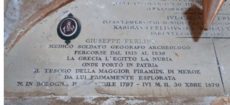Giuseppe Ferlini
| Giuseppe Ferlini | |
|---|---|
 Ferlini's tomb, Certosa di Bologna | |
| Born |
April 23, 1797 Bologna, Italy |
| Died |
December 30, 1870 (aged 73) Bologna |
| Resting place | Certosa di Bologna |
| Nationality | Italian |
| Occupation | medic, explorer, treasure hunter |
| Known for | the plundering of the pyramids of Meroë |
Giuseppe Ferlini (April 23, 1797 – December 30, 1870[1]) was an Italian combat medic turned explorer and treasure hunter, well known for having raided and vandalized several pyramids of Meroë.
Biography
Born in Bologna, it is known that since 1815 he travelled across Greece and later he reached Egypt;[1] here he joined the Egyptian Army during the Egyptian conquest of Sudan and in 1830 he became surgeon-major. Under the army, he stayed at Sennar and then at Khartoum where he met the Albanian merchant Antonio Stefani.[2] Later he decided to desert and devote himself to treasure-hunting, determined to either “return home penniless, or carrying unprecedented treasures”.[3] Along with Stefani, Ferlini organized an expedition that left for Meroë on August 10, 1834.[2]
Once arrived at Meroë, and incited by the local workers who talked about a legend regarding 40 ardeb of gold, Ferlini started to raid and demolish several pyramids, which were found “in good conditions” by Frédéric Cailliaud just a few years earlier.[3] At Wad ban Naqa, he leveled the pyramid N6 of the kandake Amanishakheto starting from the top, and finally found her treasure composed of dozens of gold and silver jewelry pieces. Overall, he is considered responsible for the destruction of over 40 pyramids.[3][4]

Having found the treasure he was looking for, in 1836 Ferlini returned home.[1] A year later he wrote a report of his expedition containing a catalog of his findings, which was translated in French and republished in 1838.[note 1][2] He tried to sell the treasure, but at this time nobody believed that such high quality jewellery could be made in Black Africa. His finds were finally sold in Germany: part of these were purchased by king Ludwig I of Bavaria and are now in the State Museum of Egyptian Art of Munich, while the remaining – under suggestions of Karl Richard Lepsius and of Christian Charles Josias von Bunsen – was bought by the Egyptian Museum of Berlin where it still is.[3]
Ferlini died in Bologna on December 30, 1870 and was buried in the Certosa di Bologna.[1]
Notes
- ↑ Giuseppe Ferlini, Relation Historique des Fouilles Operées dans la Nubia par le docteur Joseph Ferlini de Bologna, suivie d'un catalogue des objets qu'il a trouvés dans l'une des quarante-sept pyramides aux environs de l'ancienne ville de Meroe, et d'une description des grands déserts de Coruscah et de Sinnaar. Rome, 1838.
References
- 1 2 3 4 Inscription from his gravestone in the Certosa di Bologna (see picture).
- 1 2 3 Dawson, Warren R.; Uphill, Eric P. (1972). Who Was Who in Egyptology. London: Harrison & sons.
|access-date=requires|url=(help) , p. 166 - 1 2 3 4 Cimmino, Franco (1996). Storia delle Piramidi (in Italian). Milano: Rusconi. ISBN 88-18-70143-6. , pp. 416-7
- ↑ Welsby, Derek A. (1998). The kingdom of Kush: the Napatan and Meroitic empire. Princeton, New Jersey: Markus Wiener. , pp. 86; 185